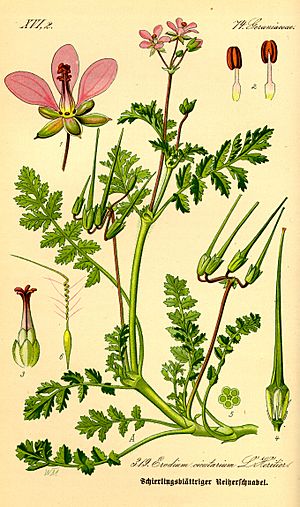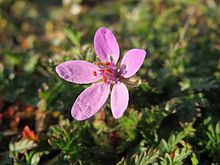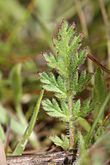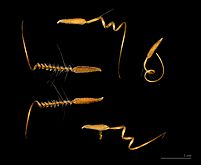Redstem filaree facts for kids
Quick facts for kids Redstem filaree |
|
|---|---|
 |
|
| Scientific classification | |
| Genus: |
Erodium
|
| Species: |
cicutarium
|
| Synonyms | |
|
Geranium cicutarium L. |
|
Erodium cicutarium, also known as redstem filaree or common stork's-bill, is a type of flowering plant. It's usually an annual plant, meaning it lives for one year. In warmer places, it can be a biennial, living for two years. This plant belongs to the Geraniaceae family. It originally comes from places like Macaronesia, parts of Europe and Asia, and North Africa. In the 1700s, it was brought to North America. Now, it grows naturally there, especially in the dry deserts and grasslands of the southwestern United States.
Contents
Where Redstem Filaree Grows
This plant is found all over North America. In the northern parts, it grows for one year. In the southern areas, it often grows for two years. There, it tends to be taller with bigger leaves, flowers, and fruits. It usually blooms from May to August.
You can find common stork's-bill in open, sandy, or grassy areas. It grows both inland and near the coasts. This plant is also a food source for the young (larvae) of the brown argus butterfly. Different kinds of harvester ants also collect its seeds.
What Redstem Filaree Looks Like
Redstem filaree is a plant that feels hairy and a bit sticky. Its stems have bright pink flowers. These flowers often have dark spots near their bases. The flowers grow in a loose group. They have ten thin parts called filaments, but only five of these can help make new seeds. They also have five styles, which are part of the flower's reproductive system.
The leaves are divided into many smaller parts, like a feather. The stems of the leaves are also hairy. The plant has a long seed-pod that looks like a stork's bill. When it's ready, this seed-pod bursts open in a spiral. This action sends the seeds, which have long tails called awns, flying into the air.
How Redstem Filaree Seeds Travel
The seeds of Erodium cicutarium have special ways to move away from the parent plant. This helps them find good places to grow. The plant uses two main methods: explosive dispersal and self-burial.
Explosive Seed Launch
After the plant flowers, five parts of the fruit, called pericarps, and their hair-like tails, called awns, join together. They grow into a spine shape. As the fruits dry out, they lose water. This creates tension and stores energy in the awns. The awns then change shape from straight to a spiral. This causes them to explosively launch the seeds away from the plant. This stored energy helps the seeds fly further. The amount of energy stored depends on how much water is in the plant.
Seeds That Bury Themselves
Once a seed lands on the ground, its awn reacts to the moisture in the air. The awn coils up when it's dry and uncoils when it's wet. This movement helps the seed to "walk" across the soil. Tiny hairs on the seed and awn also help it move. Eventually, the seed finds a small crack or hole. The coiling and uncoiling action then helps the seed drill itself into the ground.
This movement happens because of special tissue in the awns that reacts to water. When the tissue absorbs water, it expands and straightens the awn. When it dries out, it shrinks and coils the awn.
Scientists have studied how far seeds travel. They found that the weight of the seeds didn't affect how far they were launched. Larger seeds took longer to coil and uncoil than smaller ones. In nature, fewer seeds got buried as the season went on. Larger seeds buried themselves more often. However, smaller seeds found holes and drilled themselves in more easily.
Why These Methods Are Good
The explosive launch and self-burial methods help the seeds get into the ground quickly. This is important during the best time for them to be buried by the moisture-driven movements. This helps more seeds survive and grow into new plants.
Uses of Redstem Filaree
The young leaves of the redstem filaree can be eaten raw or cooked. Some people say the whole plant tastes a bit like strong parsley if picked when it's young.
The pink flowers of this plant are also a good source of nectar for bees. This means they help bees make honey. They also provide a lot of pollen.
The Zuni people, a Native American tribe, have used this plant in traditional medicine. They would chew the root and put it on sores and rashes. They also made a drink from the root to help with stomachaches.
Nutrition Facts
| Nutritional value per 100 g (3.5 oz) | |
|---|---|
| Energy | 96 kJ (23 kcal) |
|
7.9 g
|
|
| Sugars | 4.3 g |
| Dietary fiber | 3.0 g |
|
0.1 g
|
|
|
Protein
|
0.6 g
|
| Vitamins | Quantity
%DV†
|
| Vitamin A equiv. |
25%
200 μg |
| Vitamin C |
2%
2.03 mg |
| Minerals | Quantity
%DV†
|
| Calcium |
7%
74.3 mg |
| Iron |
17%
2.2 mg |
| Magnesium |
6%
20 mg |
| Phosphorus |
4%
28 mg |
| Potassium |
7%
223.4 mg |
| Sodium |
1%
18.9 mg |
| Zinc |
4%
0.4 mg |
| Other constituents | Quantity |
| Water | 90.6 g |
|
[1]
|
|
| †Percentages estimated using US recommendations for adults. | |
Raw redstem filaree is mostly water (about 90.6%). It also contains carbohydrates (7.9%), protein (0.6%), and dietary fiber (3%). It has very little fat (0.1%).
See also
 In Spanish: Alfilerillo cicaturo para niños
In Spanish: Alfilerillo cicaturo para niños




